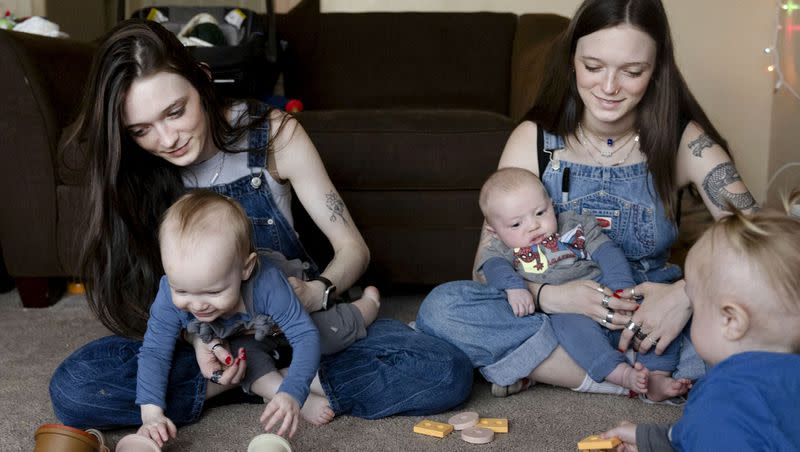Twinning is winning ... right? The highs and lows of being a twin

When my mom gave birth to twins, I don’t think she imagined they would be birthed a full 30 minutes apart, but that’s exactly what happened.
I’m 30 minutes younger than my twin sister, Susitina. We are fraternal twins.
Fraternal twins form when two separate eggs are fertilized by two separate sperm, creating two babies that share half of their genes.
Identical twins, like Utah natives Hailey Barton and Hannah Case, happen when a single egg is fertilized by a single sperm and split into two, creating two babies that are practically identical.
“Most of the time people will assume being a twin is your whole personality,” Barton said. Case echoed the thought, adding “Just the insinuation that we always have to do everything together is kind of annoying.”
“It’s a blessing and a curse,” Joan Friedman, psychotherapist and clinical social worker, told the Deseret News.
While fraternal twins might not be the same gender or have similar appearances, identical twins usually share physical similarities and gender, with some rare exceptions listed by health news outlet Healthline.
With appearances, personalities, skill sets, talents and temperaments, Friedman said, “Identicals happen to be more alike in a lot of those dynamics, whereas fraternals are just like two very different kids.”

Chances of having a twin
The chance of having twins is about 3% in the U.S., with 31 twin births per 1,000 live births, the U.S. Centers for Disease Control and Prevention says.
That means you have a much greater chance of surviving an accidental fall off a four-story building than you do of being born a twin, according to preparedness education outlet Offgrid.
Twins have been associated with signs of good luck, consistent friendship and pop culture references, including in movies like “The Parent Trap” or “Twitches.”
However, there are hardships in being a twin that don’t usually make it on the silver screen: friction created because of relationships outside the twinship, constant comparison, managing jealousy and lost individuality, to name a few.
No set of twins is the same, nor do they have the same relationship.
Twin types
In Psychology Today, twins expert Barbara Klein describes examples of twinships, including:
“Get-along twins” celebrate their differences and support one another, but their tight bond may get in the way of making other close friends.
“Leave-me-alone twins” value harmony beyond what’s practical and are so careful with each other’s feelings that they only talk to each other when there is no other choice.
“Afraid-of-one-another twins” have argued so much and see themselves as so different that they avoid each other entirely.
“Twins with murderous rage” are estranged because they’ve competed with and been pitted against each other all their lives, so they are not close.
A dose of twin reality can be found reading international twin development expert Barbara Klein’s article on twin estrangement, which she describes as an emotional experience of serious avoidance between twins, causing feelings of shame, fear and resentment.
Intense joy and deep grief is often part of the complex, dynamic relationship between twins. And others often misunderstand them.
Challenges
Klein describes the unique attachment style of twins as being “born married,” since it’s unlike a mother-child or sibling attachment, the assessment in an article for Psychology Today.
Nancy Segal, professor of psychology at California State University Fullerton, told the Deseret News that since differences in fraternal twins are more apparent than identical twins, “People often say unkind things like who’s the smarter one? Who’s the prettier one? Or, you’re obviously the smart one but she’s obviously the cute one. People have a way of saying things that they think are not harmful and, in fact, they are.”
Often, even friends struggle to address identical twins as two separate individuals with two separate lives, Barton and Case told the Deseret News in a joint interview.
When it comes to male-female twinships, since girls mature faster than boys, the girl has a tendency to boss the boy around in the early years, said Segal. She’s written a number of books about twins, including her just-released “The Twin Children of the Holocaust: Stolen Childhood and the Will to Survive.”
Friedman found within her own sphere of practice that “a different gender can become very overprotective, critical or upset by the brother or sister getting married.” She said she’s seen this in many twinships that have come to her for counseling.
When Barton got married, Case admits feeling happy for her twin while also feeling “like I was behind a bit. Like I was doing something wrong because she was at that point in her life and I wasn’t.” She added, “There was kind of some unacknowledged resentment — not towards her or her boyfriend or anything like that, just kind of anger with myself, I guess.”
Even after both twins wed, they experienced sometimes feeling left out whenever the other twin spent time with other people, like friends or in-laws.
With twin experiences, Friedman said that normal emotions like envy or competitiveness “have the potential of becoming really explosive, hideous, scary, awful things for twins.”
Whatever life throws at twins, both are affected by it to some degree. This immediate intimacy, paired with individual life experiences, can cause drifts between them, Friedman said.
In both friendships and family relations, Barton said, “There’s always going to be, I don’t want to say a favorite twin, but preferred for some people,” which can cause friction and feelings of exclusivity and jealousy. She said it can be hard to navigate any kind of relationship when such preferences surface.
Case said that in the past, dating was sometimes hard. If someone was rejected by one twin, they would turn to the other. She was once told, “You guys are the same person, so it doesn’t matter which one I get.”

Advantages
But even through the experiences of resentment, comparison and envy, Barton and Case still deem the other their best friend.
Case said, “I very genuinely think she’s my very best friend in the whole world and I know that that’s not the case with a lot of twins.”
“Being a twin is special! You’re a minority in the population,” Segal said. “You have somebody that’s gone through so many of the same things that you’ve gone through, at the same time.”
Friedman agrees. “There’s a seamless kind of thread that connects them in a way, that makes their relationship so special and so beautiful. And if they can carry that seamless peace through their adulthood,” it can be a beautiful connection.
Barton and Case have both started families and now navigate motherhood together. Case said, “The only reason that I knew I could do it was because Hailey (Barton) was keeping her baby as well.”
Segal said while some might think twins are a big job for families, having twins has some built-in pluses. “Some of the advantages to parents is that you’re out of diapers at the same time. With ordinary siblings, you’re done with diapers with one and start with the other. Also, twins have each other as entertainers. They entertain one another and free up parental time, which is a real advantage.”
Segal encourages parents to join local parents-of-twins clubs, where they can find support, information and advice within their community.
In terms of competition, Segal said some pairs of identical twins regard a victory for one of them as a mutual victory. She admires that “lack of selfishness.” “I think that twins should be allowed to enjoy their twinship, too. You know, identical twins in particular may like to dress alike — you know, fool people occasionally.”
After spending so much time around each other, Friedman said twins may be able to understand each other just by body language, facial expression or other nonverbal cues.
Segal calls that twin language, when twins “develop sort of a private pattern of words and gestures and phrases.” Without proper exposure to situations apart from one another or one-on-one time with parents, Segal said twins could begin to grow reliant on this.
This is why she pushes for parents to build individual relationships with their twins.
Related
Addressing twins
Friedman and Segal both stressed the importance of parents spending one-on-one time with each twin.
“People often equate twinship with similarity,” Segal said. Friedman said similarities are often emphasized by parents, which can make accessing individuality and minimizing competition difficult.
“If the parents are relating to the twins as a dyad, as a unit, then those twins don’t get the important parent-child connection that you would just naturally and normally give to one child. So a big factor is how the parents have understood or learned or recognized the importance of creating their own separate relationship with each child,” Friedman said.
Another important factor in addressing twins is making sure to give them two very different-sounding names, according to Segal. “You make sure other people know that name; that is so important.”
Barton said being called the wrong name by people who knew her personally, like family, was really bothersome. “In high school, we were the Barton twins,” Case said, acknowledging people often didn’t call them by their individual names, which showed a lack of interest and effort to really connect with them separately.
Twins deserve individual attention, the same you would give anyone else.
“You got to pay attention to twins,” Segal said. “You can’t come with these preconceived notions that twinship implies x, y and z. Twins in their own way will let you know what’s best for them.”
Steering a conversation to be centered on one twin when speaking with the other or talking negatively about one twin to the other is something Case and Barton find insensitive and wrong.
“I just don’t get why people would ever try to talk about her negatively to me because it highlights how they don’t understand the kind of relationship that twins have,” Barton said.
Closer to home
I asked my own twin, Susitina Heimuli, her thoughts on being a twin. She talked about a magnetic pull that was “almost suffocating” when we were little and trying to become individuals. But the pull just gets stronger.
“That’s when you learn to stop fighting it. To nourish that pull and to come together as two souls, forever intertwined,” she told me.
She said suffocating was the wrong word. Looking back, she’d choose “strengthening. You’re better together, unstoppable, if you will.”
Then she added, “No matter the challenges or how hard things may seem between us, life is forever worth it with your other half.”

